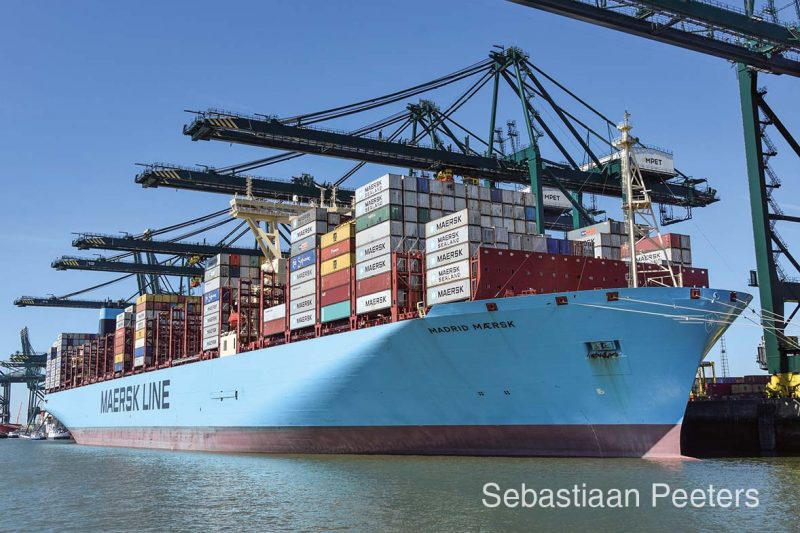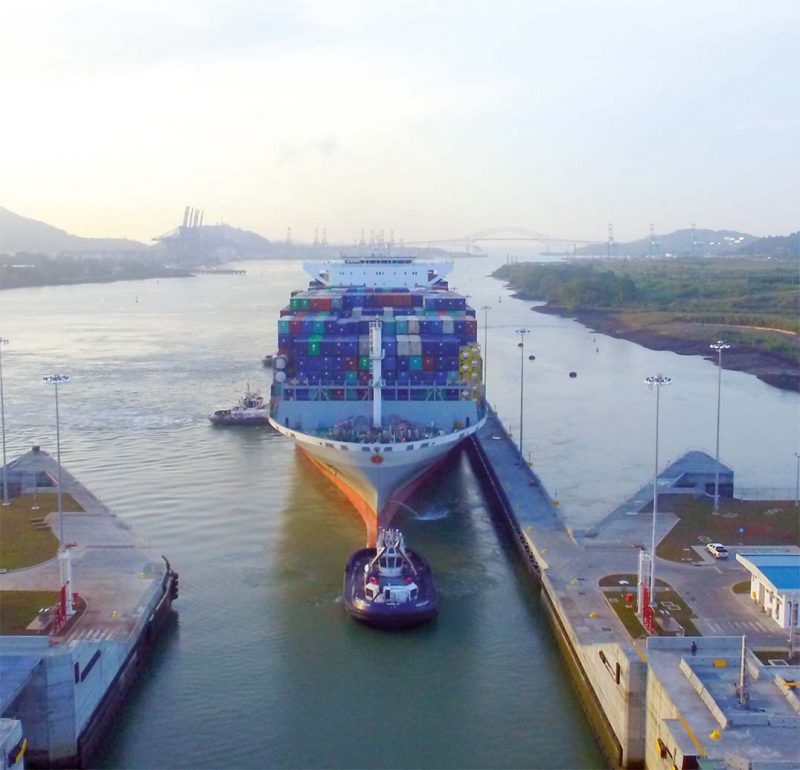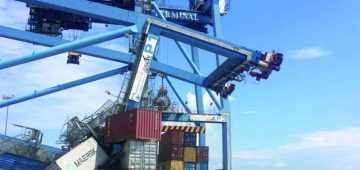CMA CGM reported a consolidated net income of $86m in the first quarter of 2017, a significant rebound from a net loss of $100 million posted in the first quarter of 2016 suppressed by pressured freight rates. During the quarter, volumes carried marked a strong increase of 34.2% in comparison to the first quarter of 2016, thanks to the integration of APL. According to CMA CGM, for the first time, and less than a year after its acquisition, APL has contributed positively to the group’s results. Specifically, it achieved a gross operating income of $56 million and its net result was a profit of $26m. The group’s consolidated revenues were up by 35.9% in comparison with the same period of 2016, standing at $4.6 billion.
Deltamarin’s energy-efficient cargo ship family has reached yet another milestone as Icelandic Eimskip Ltd. and Greenland-based Royal Arctic Line A/S ordered the first three container vessels based on Deltamarin’s design. The ships will be built at the Guangzhou Wenchong Shipyard in China, with which Deltamarin (China) Co. Ltd. has signed a design contract. Deltamarin earlier developed the vessel concept for the two ship owners to fit their trading routes. The 180m long and 31m beam ships are designed to achieve the best possible key performance indicators, such as container carriage variety, homogenous loading capacity, optimal manoeuvrability and harsh weather seakeeping performance. The highly fuel-efficient and environmentally-friendly 2,150 TEU capacity container vessels are capable of sailing even in Arctic waters. They will have an ice class and comply with the newly adopted IMO Polar Code. The work will be carried out at Deltamarin’s Shanghai office in China over an estimated period of eight months.
Euroseas Ltd. has signed a memorandum of agreement to purchase the EM Astoria, a 30,024gt/2004-built feeder-size containership. Featuring a capacity of 2,788 TEUs, the vessel is to be acquired at market price from Euromar LLC, the company’s joint venture with two private equity firms. Delivery was expected to Euroseas in June 2017.
Hapag Lloyd’s merger with the United Arab Shipping Company (UASC) was concluded on 24th May. The merger was completed in Hamburg some 10 months after the business combination agreement (BCA) was signed between the two container lines. The merger was originally scheduled for completion on 31st March 2017 but the process ran into complexities with the documentation so the deadline was deferred. The combined company is the world’s fifth largest container line with 230 vessels with a total capacity of 1.6m TEU. Qatar Investment Authority and the Public Investment Fund of Saudi Arabia have subsequently become key shareholders in Hapag-Lloyd with 14.4% and 10.1% stakes respectively. Alas the merger will mean the loss of around 1,000 jobs.
Mitsui O.S.K. Lines’ MOL Triumph made her maiden call at Hamburg on 15th May, berthing at the HHLA Burchardkai Container Terminal. The new Mitsui O.S.K. Lines (MOL) flagship was the first vessel with a loading capacity of over 20,000 TEU to visit the Port of Hamburg. Sailing under THE Alliance shipping consortium, like her sister-ships, the MOL Triumph is deployed in the FE2 service between Asia and Europe. The FE2 offers a fast direct service between China and SE Asia with the western Mediterranean and northern Europe. For example, the transit time eastbound between Hamburg and Hong Kong lies around 33 days, westbound between Singapore and Hamburg 24 days. MOL has also announced that an average 2% reduction in overall carbon dioxide emissions has been achieved in live tests of its containership “windshield” technology first unveiled by the company in 2015. The in-service demonstration of the windshield, which was co-developed by MOL, was carried out aboard the MOL operated and 78,316gt/2010 built MOL Marvel. According to MOL, the test confirmed about a 2% average reduction in CO2 emissions while sailing at 17 knots after the windshield was installed on the bow of the ship. The 2% reduction is compared to operating an identical vessel at the same speed without the device installed. The containership windshield was developed as part of MOL’s “Ishin Next – MOL Smart Ship Project” that seeks to develop and introduce new technologies that will reduce vessels’ environmental impact.
Maersk Line’s new 214,286gt/2017 built Madrid Maersk made her maiden call at the Port of Felixstowe on 7th June. The 20,568 TEU capacity ship, operating on the 2M NEU2 Asia to Europe service, arrived at the port with over 6,000 TEU for the UK loaded in China and Malaysia. The previous day she had made her maiden call at Antwerp (above). Built by South Korea’s Daewoo Shipbuilding & Marine Engineering, the Madrid Maersk is 399m long, has a beam of 58.6m and is the first of Maersk Line’s 2nd generation Triple-Es, known officially as the EEE Mark II. The original Triple-Es have been regular callers at Felixstowe since 2013. Delivery of the remaining 10 Triple-E Mark II’s is expected to take place between now and the middle of 2018. Maersk Line is to reportedly run a feeder service from Salalah, Oman, to Qatar for import and export cargo from the rest of the world following a ban ships calling at Qatar by neighbouring countries. The previous week, in an escalation of a diplomatic row, UAE, Saudi Arabia, Bahrain and Egypt cut sea and air links with Qatar. This includes non-Qatar flagged or owned international vessels barring them from calling at key regional hubs such as Jebel Ali in the UAE if they are also calling in Qatar, preventing container operators from using their usual service links for Qatar. The 10-day frequency service started from Salalah on 19th June, arriving in Doha, Qatar on 25th June. Container operators to suspended calls include Evergreen and OOCL.
MPC Container Ships AS, a fledgling containership operator, reported in late May that it had acquired seven container vessels for a total investment of $38 million. The company was formed in April by Hamburg based MPC Capital AG, an international asset and investment manager, as an investment company with a focus on small-size containerships between 1,000 and 3,000 TEU and raised $100 million in equity in a private placement aimed at international institutional investors and family offices in the Norwegian capital market. Following its corporate investment strategy, MPC Capital is a co-investor. The company’s fleet now consists of the 2007 and 2008 built sister ships AS Laetitia and AS Laguna (966 TEU), the 2009 built Rickmers Malaysia (1,300 TEU, to be renamed AS Fortuna), the 2004 built Rio Taku (2,556 TEU), the 28,596gt/2003 built sister ships AS Carinthia and AS Cardonia (2,824 TEU) and a further 2007 built vessel of 2,100 TEU. Five of the vessels have already been taken over. The remaining two were scheduled for delivery by end of June 2017. With the exception of the AS Laetitia, all ships are chartered out to liner companies at or above current market rates for periods of 6-24 months. MPC Container Ships then took delivery of the 2003-built/2,824 TEU capacity sisterships Carpathia and Cordelia on 31st May. Additionally the 14,308gt/2003 built Mare Frio, a 1,200 TEU ship, to be renamed AS Fiona, was finalised for June delivery.
MSC’s 141,635gt/2011 built MSC Cristina became the largest ever containership to call in Israel in early May. The 13,259 TEU capacity ship called at Haifa Port’s Carmel Terminal as part of a weekly service with 2M alliance partner Maersk Line. The service links South Korea, China and Singapore to Haifa Port, and from there continues to the Adriatic ports. The 151,559gt/2008 built MSC Â Daniela, which suffered a fire on 4th April whilst en-route from the Suez Canal to Singapore, has gone to China Shipping Industry’s Changxing Shipyard in Shanghai for repairs. She was expected to resume service in June. Ocean Alliance’s NEU4 service, operated by French-based CMACGM, now links the port of Zeebrugge with the Asian ports of Tianjin, Qingdao, Shanghai, Ningbo, and Yantian, China, as well as Busan, Korea. This itinerary commenced with the first call of the 13,380 TEU capacity APL CHANGI on May 16th. The NEU4 service is one of six Asia/North Europe services offered by the Ocean Alliance, which began operations on 1st April with CMA CGM, COSCO Container Lines, CMA CGM, Evergreen Line and Orient Overseas Container Line as members. The Ocean Alliance deploys approximately 350 container vessels with an estimated total container capacity of 3.5 million TEUs. The service will call at the 1.3 million annual throughput capacity APM Terminals Zeebrugge facility that, with a depth of 17m and seven STS cranes, can accommodate vessels of up to 20,000 capacity. The largest vessel handled by APM Terminals Zeebrugge to date was the 19,224 TEU capacity MSC Maya, on April 15th, 2017. The NEU4 service will deploy 12 vessels, of up to 17,859 TEU capacity.

Ocean Network Express will be the operating name of the new joint venture between Japan’s Kawasaki Kisen Kaisha (K Line), Mitsui O.S.K. Lines (MOL), and Nippon Yusen Kabushiki Kaisha (NYK Line) with an operating company to be incorporated in Singapore. In addition, regional headquarters of the operating company will be established in Singapore, Hong Kong, U.K (London), U.S.A (Richmond, VA), and Brazil (Sao Paulo). The trio of companies agreed to establish the joint venture, which will integrate the three companies’ container shipping businesses, including worldwide terminal operation businesses, excluding those in Japan, in October 2016. The plan will be officially announced once all anti-trust reviews are completed. In mid-March 2017, the proposed joint venture received an approval from the Competition Commission of Singapore (CCS). The new joint-venture company would encompass a fleet totalling 1.4 million TEU in capacity, placing the company as sixth in the market with approximately 7% of global share. K Line and MOL will each hold 31% and NYK Line will hold the remaining 38%. The new venture company will commence as from 1st July 2017 while the business will commence as of 1st April 2018.
OOCL’s 89,097gt/2005 built OOCL Tianjin called at the DCT container terminal, Gdansk, on 9th May as the first of a new service offered by the Ocean Alliance to/from Asia. Members of the alliance include OOCL, Cosco Shipping, CMA CGM, and Evergreen. The alliance’s vessels will call at Gdansk once a week, connecting ports such as Shanghai, Ningbo, Xiamen, Yantian, Felixstowe, Rotterdam, Gdansk, and Wilhelmshaven. Along with the new deep sea link, Gdansk will also expand the network of feeder connections, which will distribute containers further to individual destinations within the Baltic basin.
The 141,003gt/2013 built and 13,208 TEU capacity OOCL France became the largest vessel to transit the expanded Panama Canal on 24th May since its inauguration in June 2016. The 366.5m long and 48.2m beam Neopanamax ship transitted the waterway northbound from the Pacific to the Atlantic Ocean (above). The OOCL France is deployed on the new Ocean Alliance’s weekly South Atlantic Express (SAX) service, connecting Asia-US East Coast ports via the Panama Canal. The alliance comprises China COSCO Shipping, Orient Overseas Container Lines (OOCL), CMA CGM and Evergreen. The SAX service is comprised of eleven vessels ranging in size from 11,000 to 13,000 TEUs.
Rickmers Group, with an operational history of 60 years, filed for insolvency on 1st June, making it the most high profile casualty in Germany’s shipping sector, after its key lender HSH Nordbank rejected a restructuring plan a day earlier. The absence of support from HSH Nordbank was deemed “highly surprising” by Rickmers, leaving insolvency as the only option available. The insolvency of Rickmers marks the end of business for a five-generation German shipping family, with Bertram Rickmers currently owning 100% of the firm. The sole owner had sought to allow HSH Nordbank to become a major shareholder under the proposed restructuring deal. The restructuring plan involved 75.1% of Rickmers shares being transferred to a Luxembourg subsidiary known as LuxCo. Bertram Rickmers would accordingly see his stake diluted to just 24.9% and the remainder go to the banking group.
The problem is that banks involved in shipping lines are under pressure themselves, with HSH Nordbank having a total exposure of €17 billion to the shipping industry, of which €750 million is in loans to Rickmers. Shipping trust Rickmers Maritime, the Singapore-listed offshoot of Rickmers, itself filed for liquidation in April after bondholders refused to approve its restructuring plans in late 2016. According to online sources, Rickmers owns 33 live container vessels, with four more on order, as well as four dry bulk and two vehicle carriers. The company is also a major vessel charterer, the overall group has a total chartered and owned fleet of 114 vessels with a live fleet value of around $661m. Rickmers Maritime Trust had been prevented from selling its fleet of containerships when a Bondholder sought an injunction to halt the process but the person concerned withdrew his application in mid-May. Rickmers Maritime had earlier said the injunction was “unprecedented” in the Singapore bond market and, if allowed to proceed, could disrupt bond market processes and open the floodgates for individual noteholders to commence disruptive legal action on their own, completely disregarding the terms of the notes trust deed.
Rickmers Maritime was in the process of offloading its fleet of 14 containerships to Navios Partners Containers and Navios Partners Containers Finance for $113m with reports indicating that this will now resume. By 25th May the Navios Group had acquired the first five of the 14-containership Rickmers Maritime Trust (RMT) fleet under its master agreement with the trust. The agreement with RMT provides for the acquisition of nine additional vessels, including six sisterships to the first vessels acquired (all of which were built by Chinese yard Dalian) plus three 3,450 TEU capacity containerships that were built by Hyundai Heavy Industries. None come with long-term charters and four are currently laid up.
SeaHorse Shipping in the U.S.A has publicised a plan aimed at revolutionising container shipping and releasing both cargo shippers and shipping companies from the constraints and congestion caused by mega container ships and mega ports. The proposed SeaHorse ship system consists of a deepsea semi-submersible vessel that carries six shortsea container ships with a combined capacity of 13,500 TEUs. The deepsea vessel never needs to come into port. Instead, existing heavy lift technology is used to float out the smaller vessels which then travel to small, under-utilised and congested-free ports.
Seaspan Corporation took delivery of the 145,136gt/2017 built YM Wind, a 14,000 TEU capacity newbuilding, from Taiwanese CSBC Corporation in late May. The ship will commence a fixed rate charter with Taiwan-based Yang Ming Marine Transport Corporation for a ten-year term with an option to extend the charter for an additional two years. The 368m long/51m beam YM Wind is the ninth SAVER design containership to join Seaspan’s fleet and expands the company’s operating fleet to 89 vessels. Seaspan said it has entered into a sale-leaseback transaction for the YM Wind which provides gross proceeds of approximately $144 million. The proceeds will be used to pay for the final YM Wind delivery instalment of approximately $75 million, with the remainder to be used for general corporate purposes including debt repayment. The lease has a term of 12 years, and Seaspan has an option to purchase the vessel at a pre-determined fair value after 9.5 years.
SM Line has purchased the 4,860 TEU capacity and 50,963gt/2010 built containerships SCT Oman and SCT Qatar from Seacastle Ships of Singapore to boost the fleet to 20 ships.







Comments
Sorry, comments are closed for this item